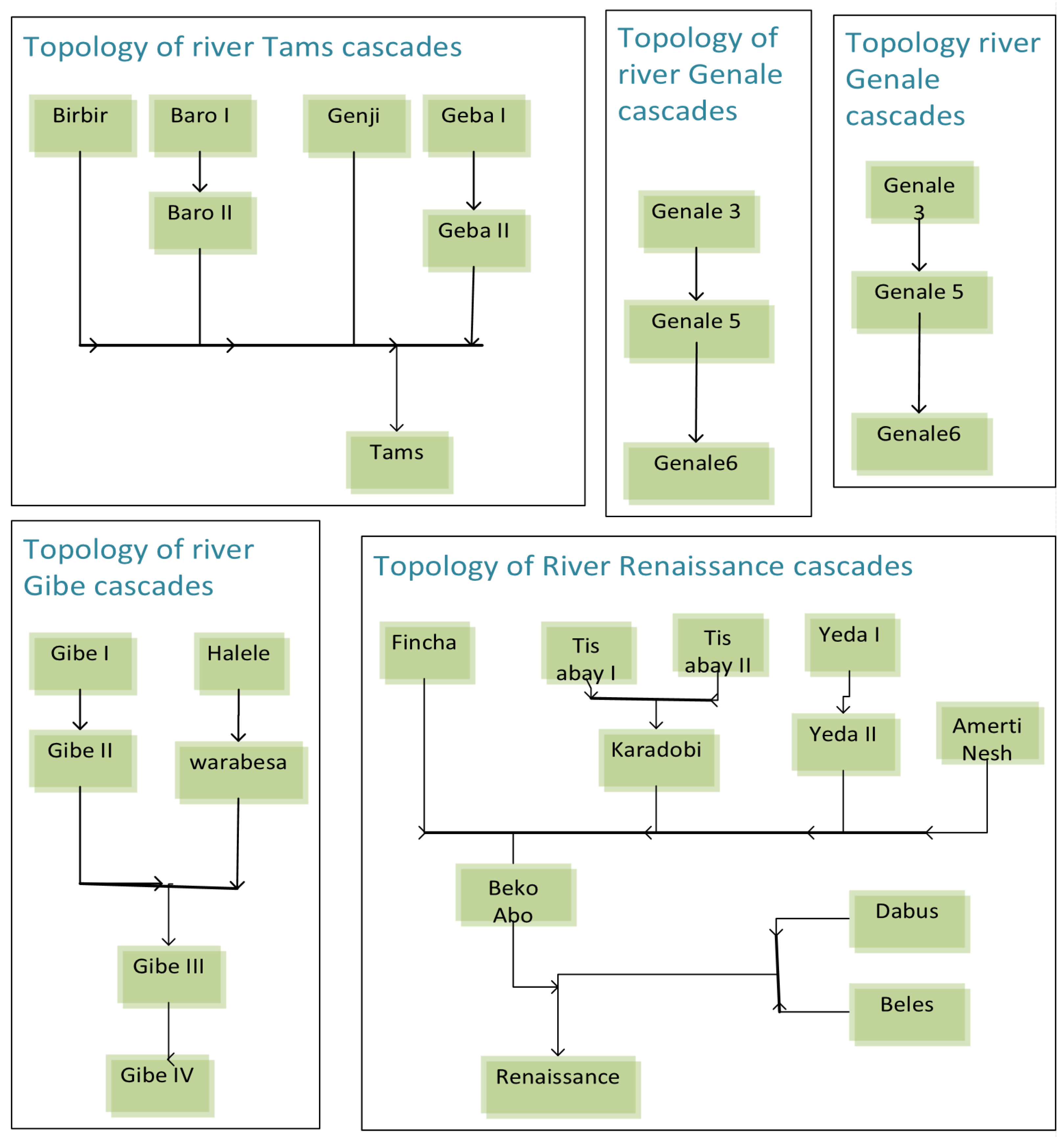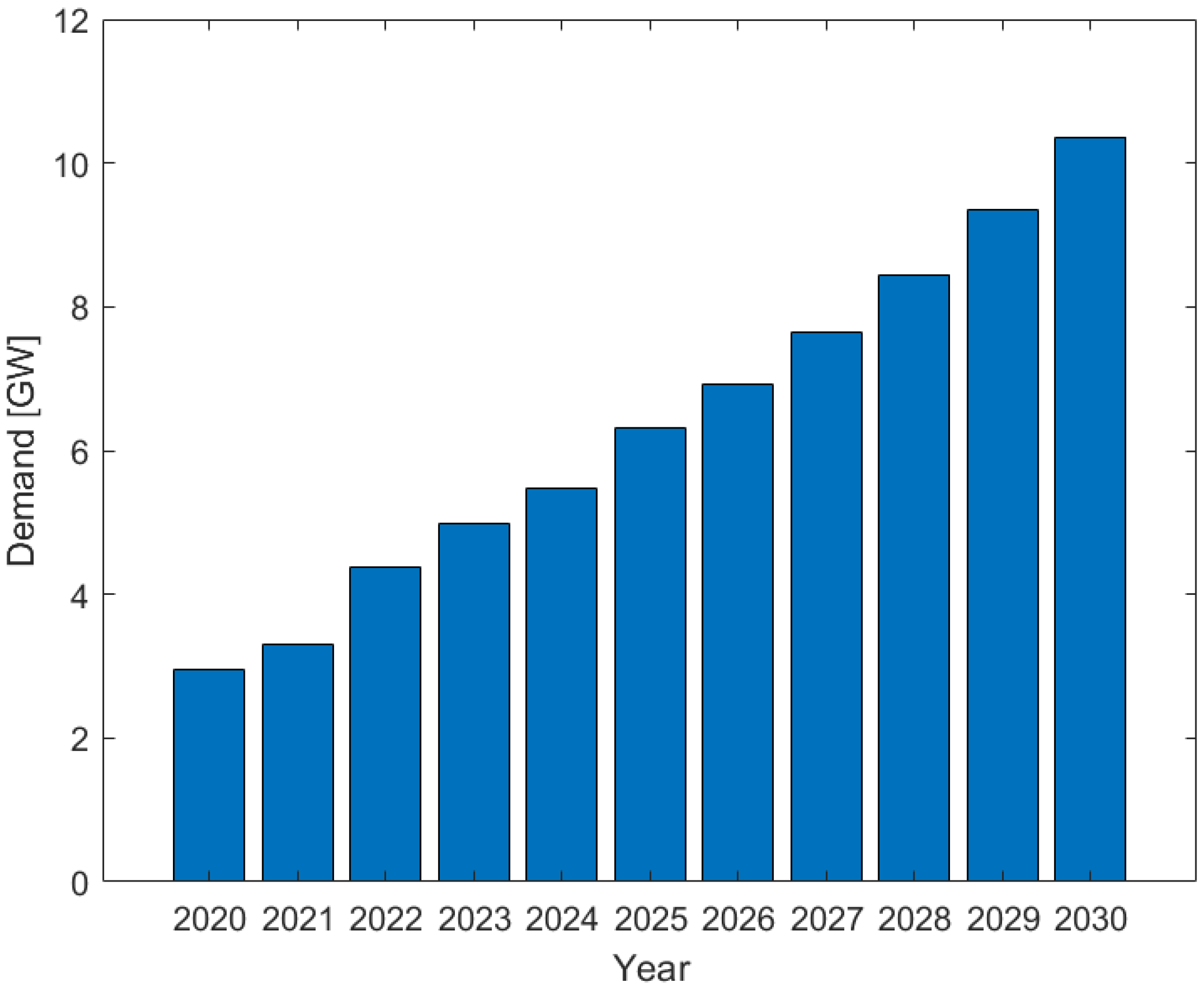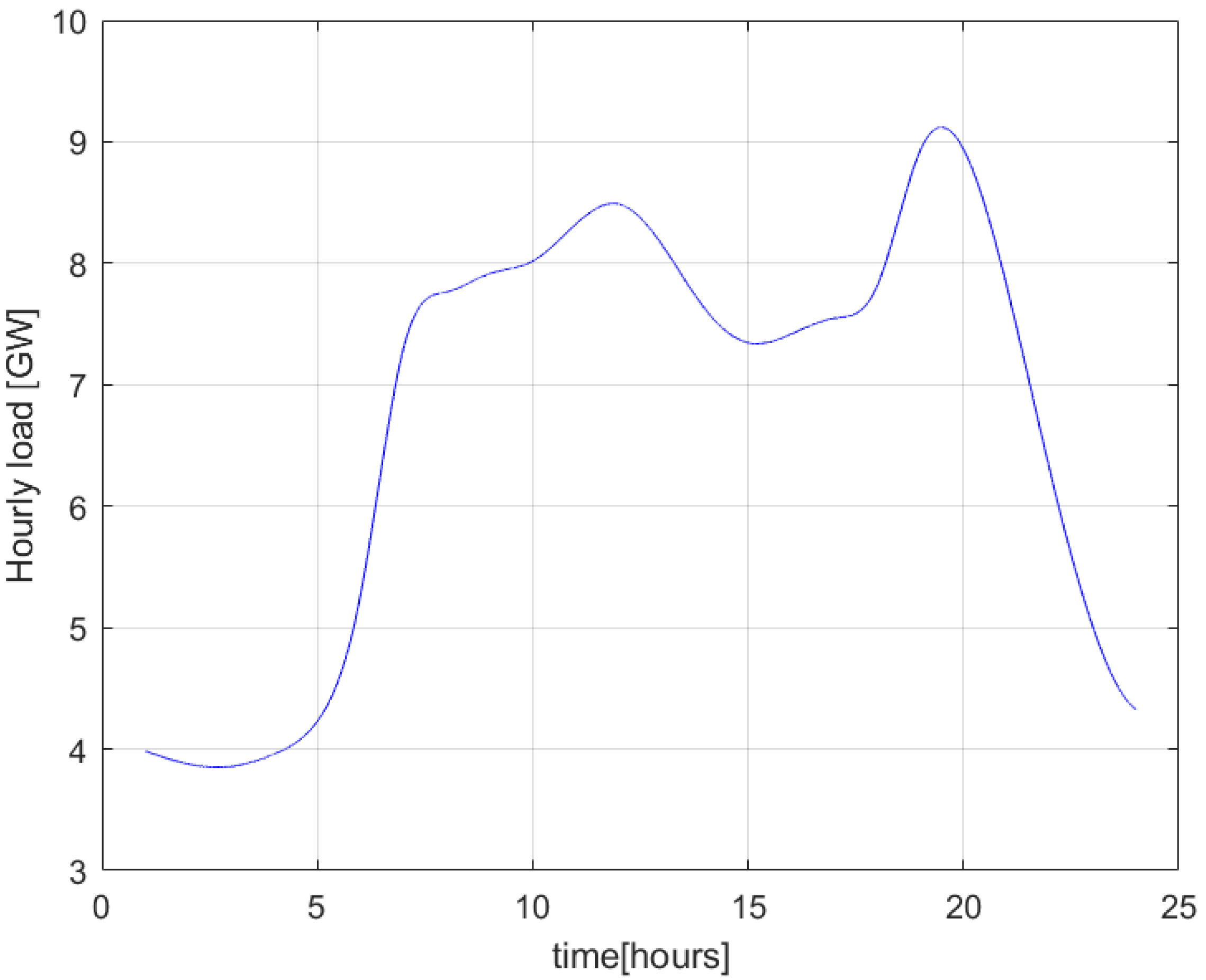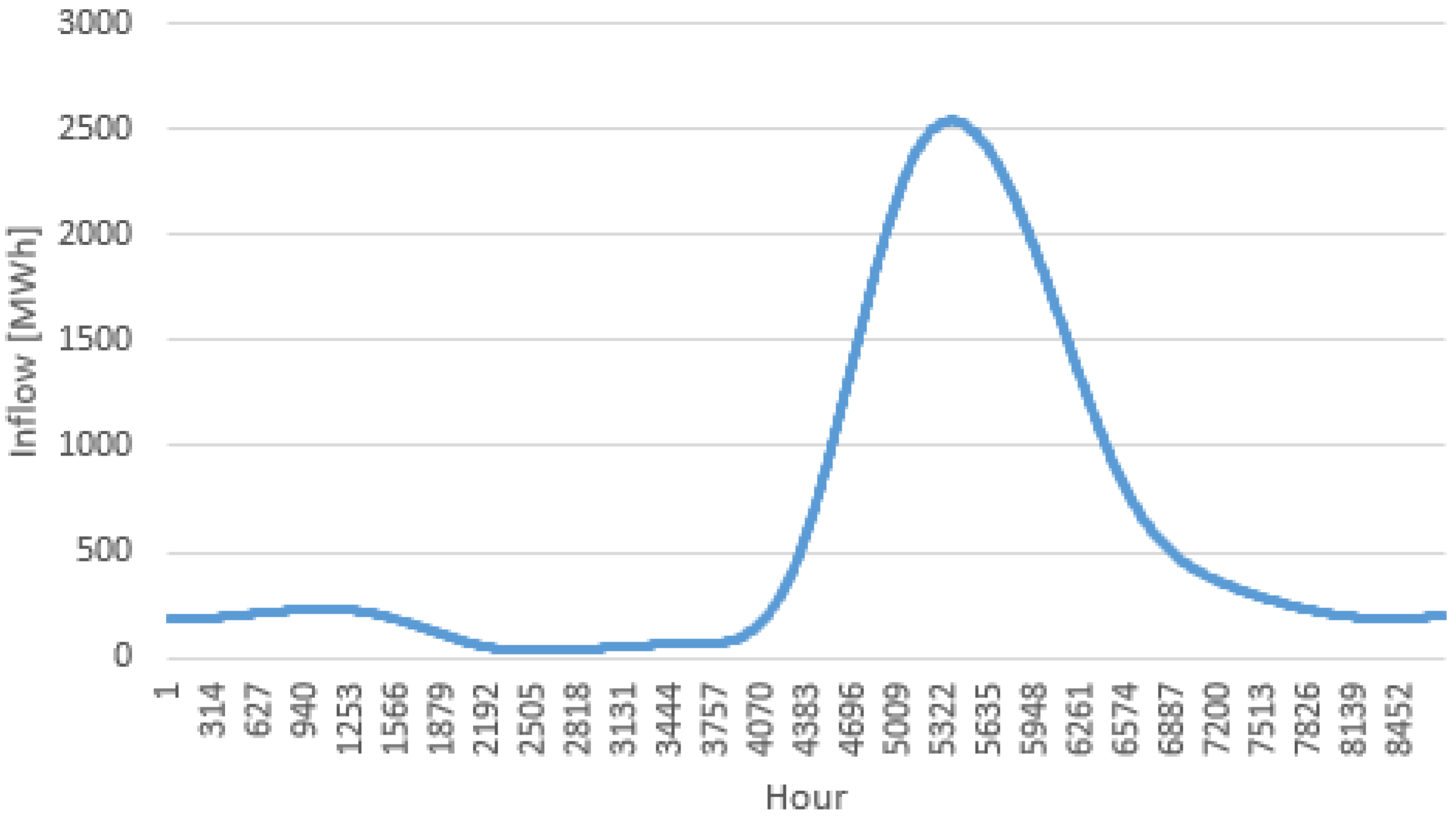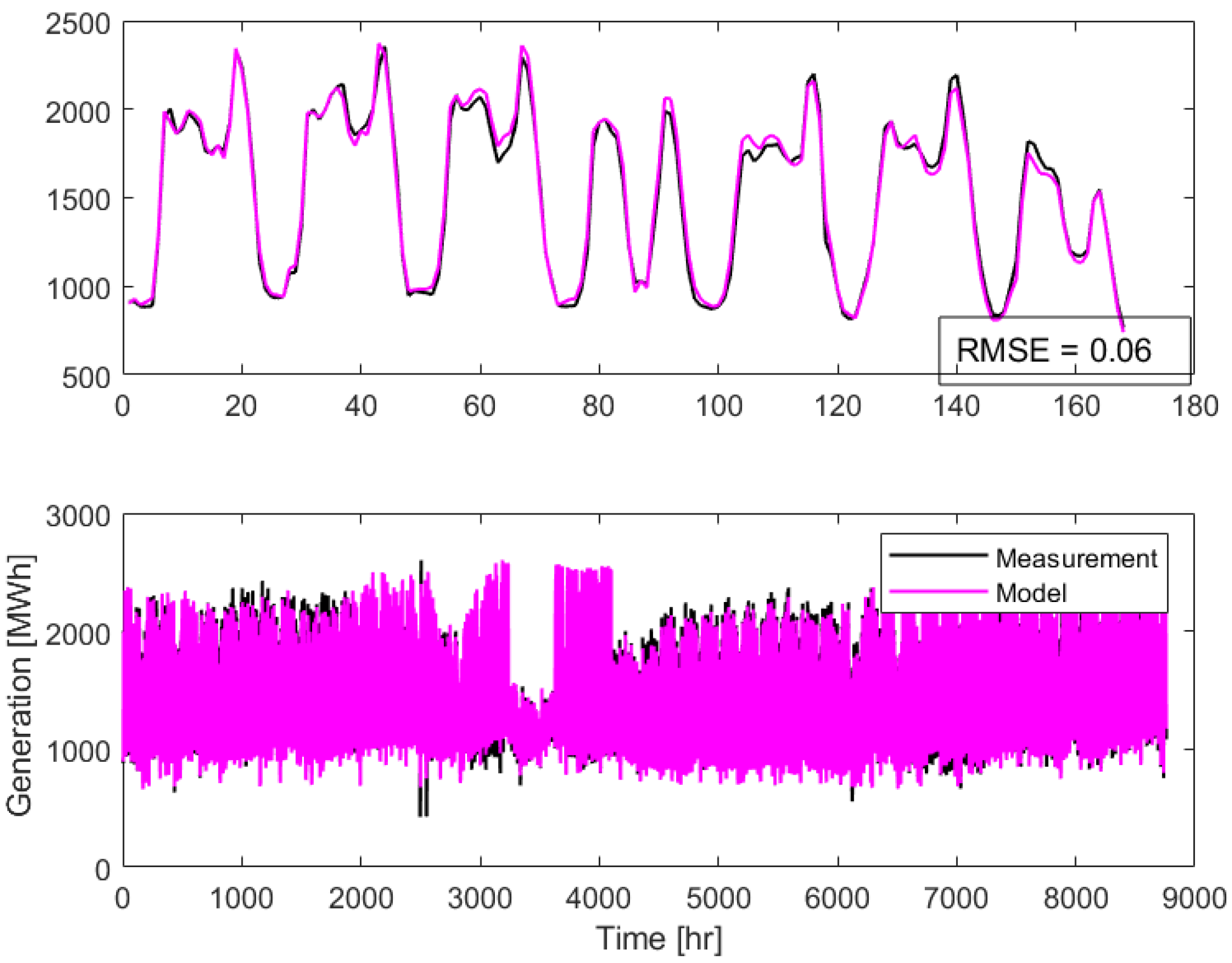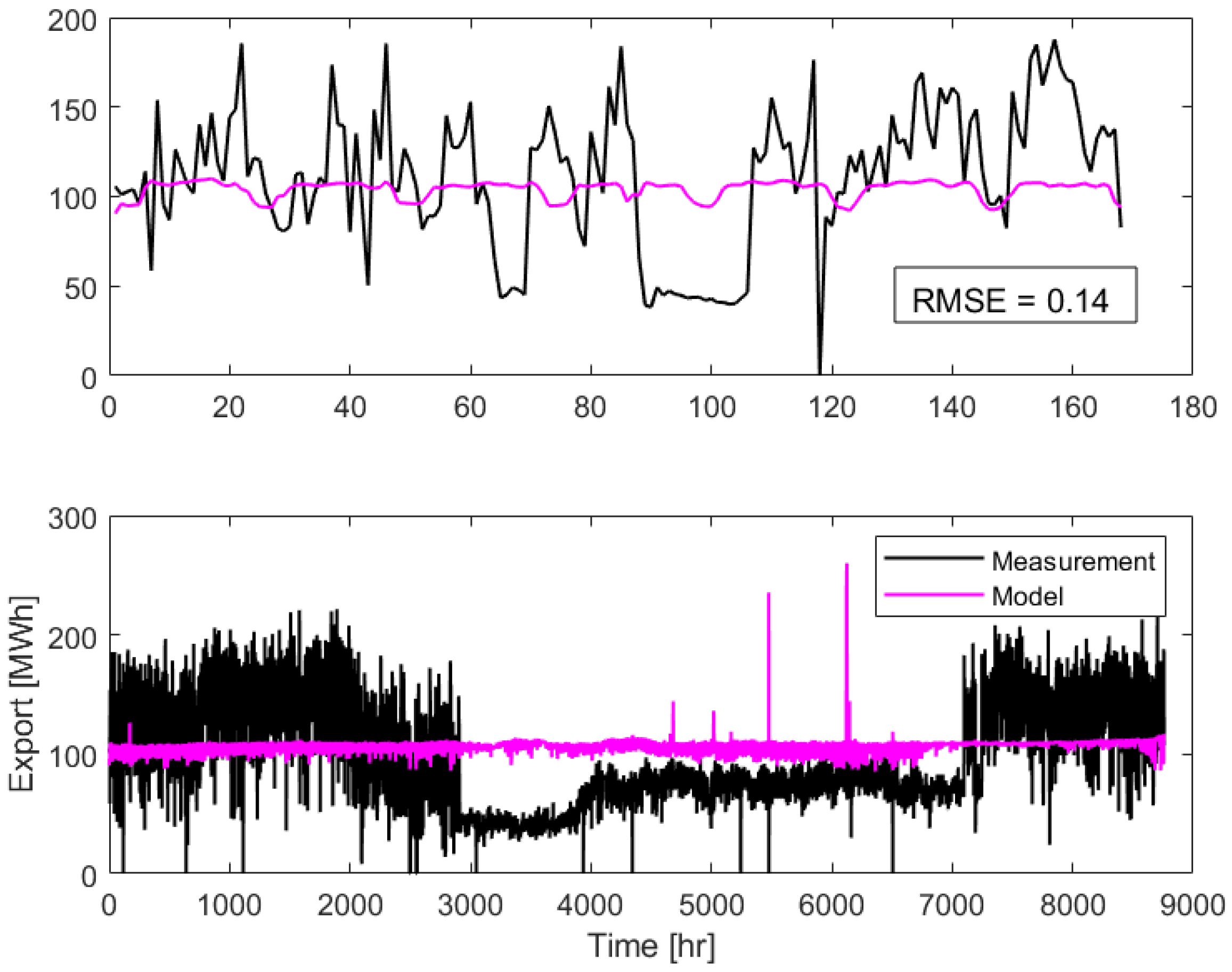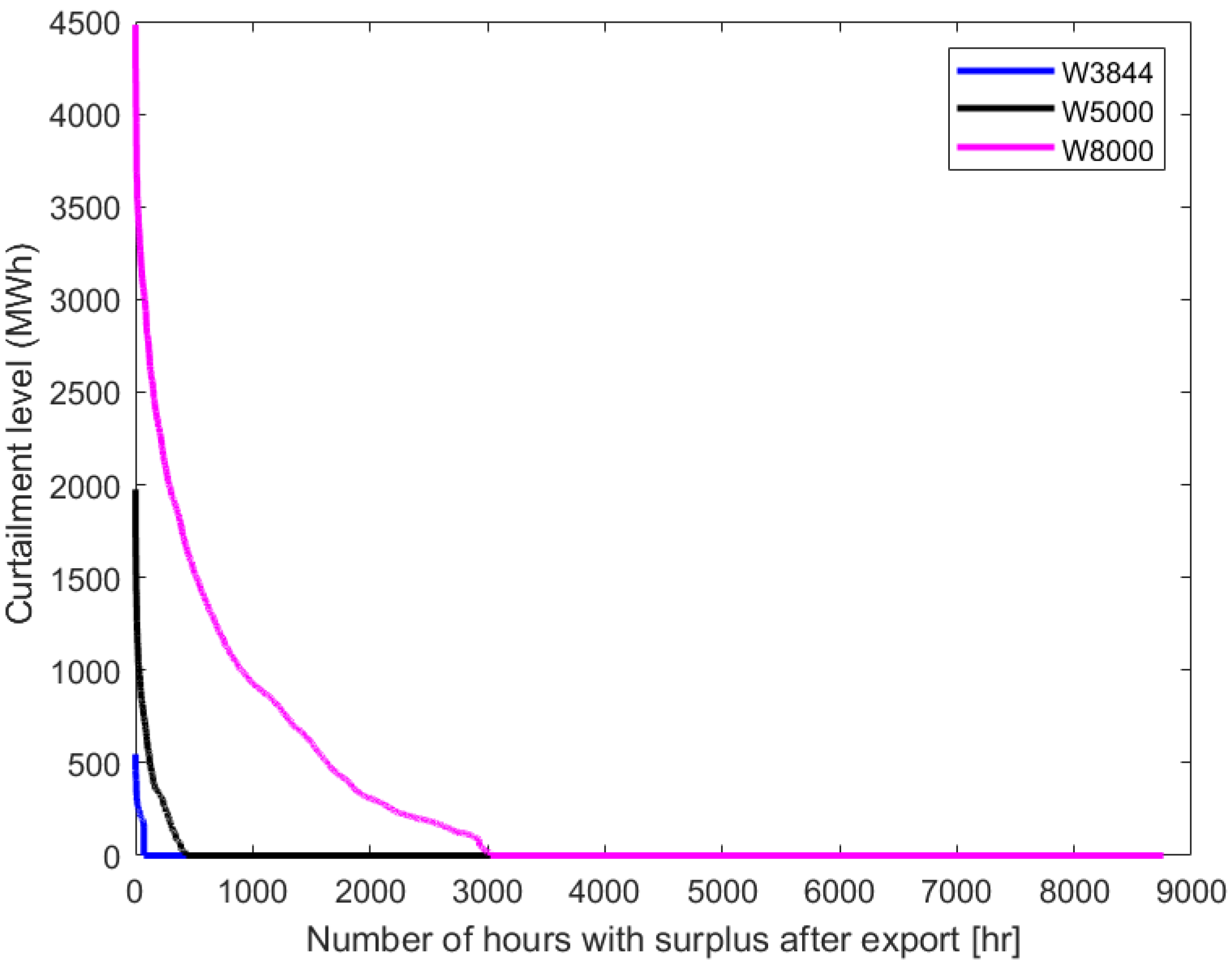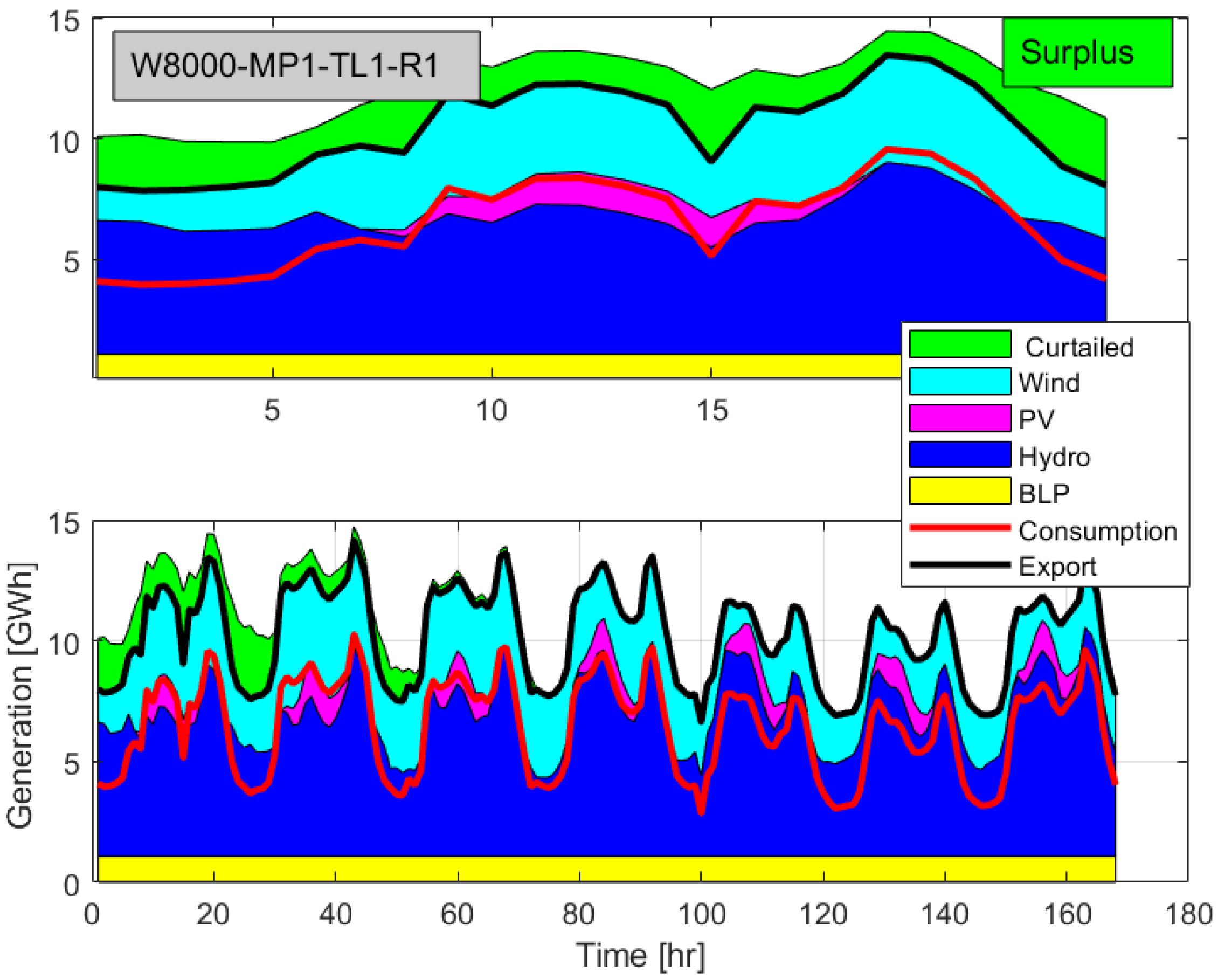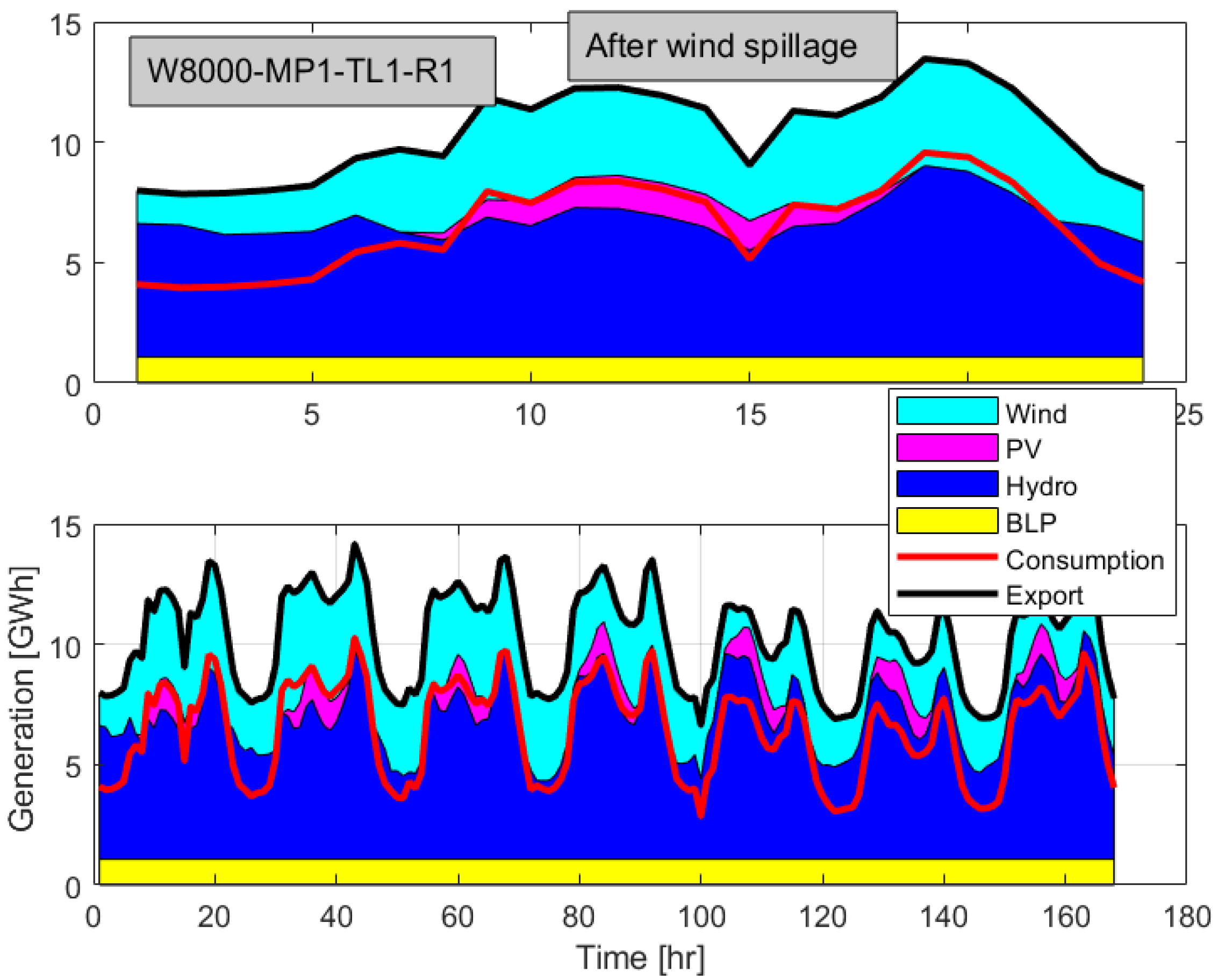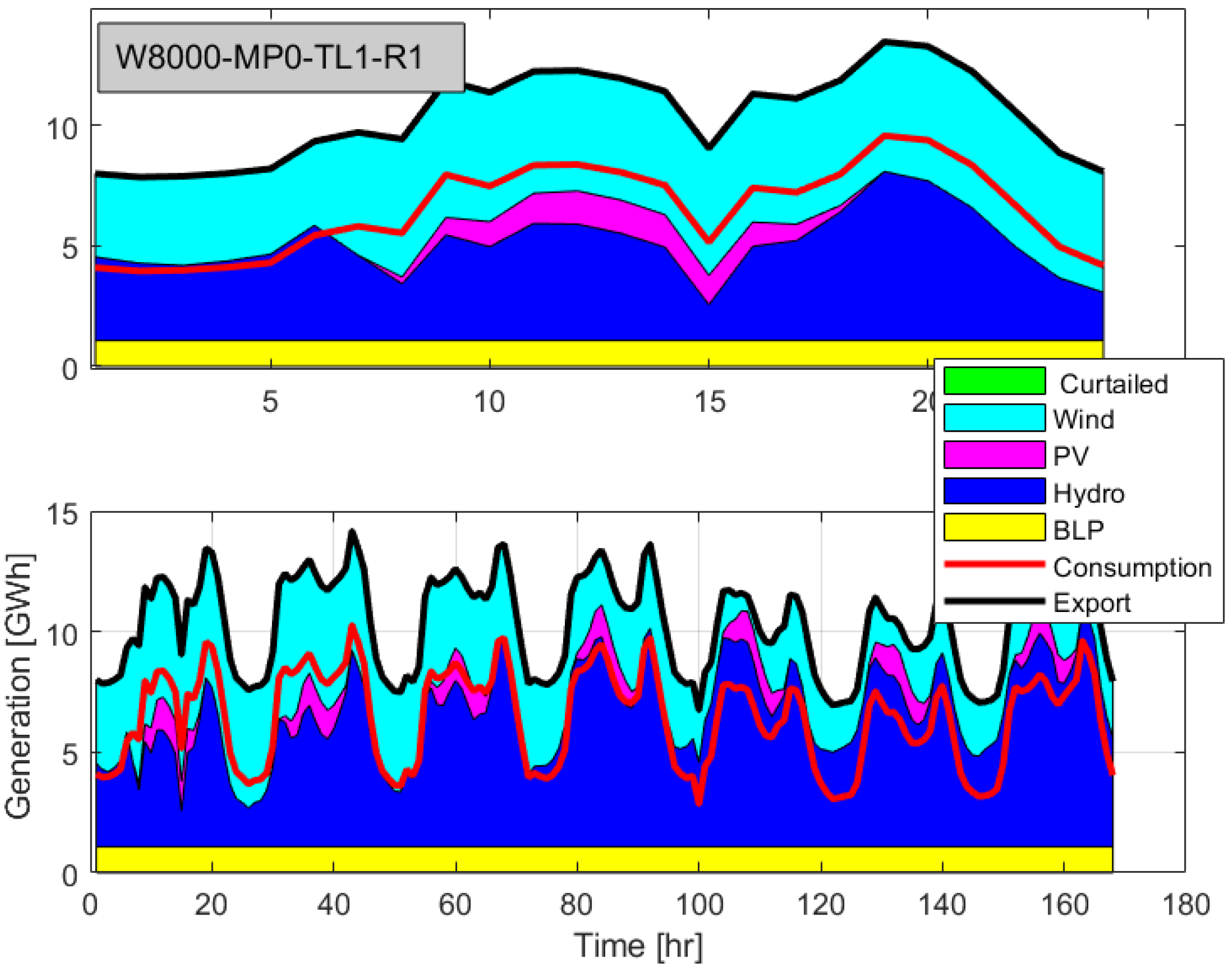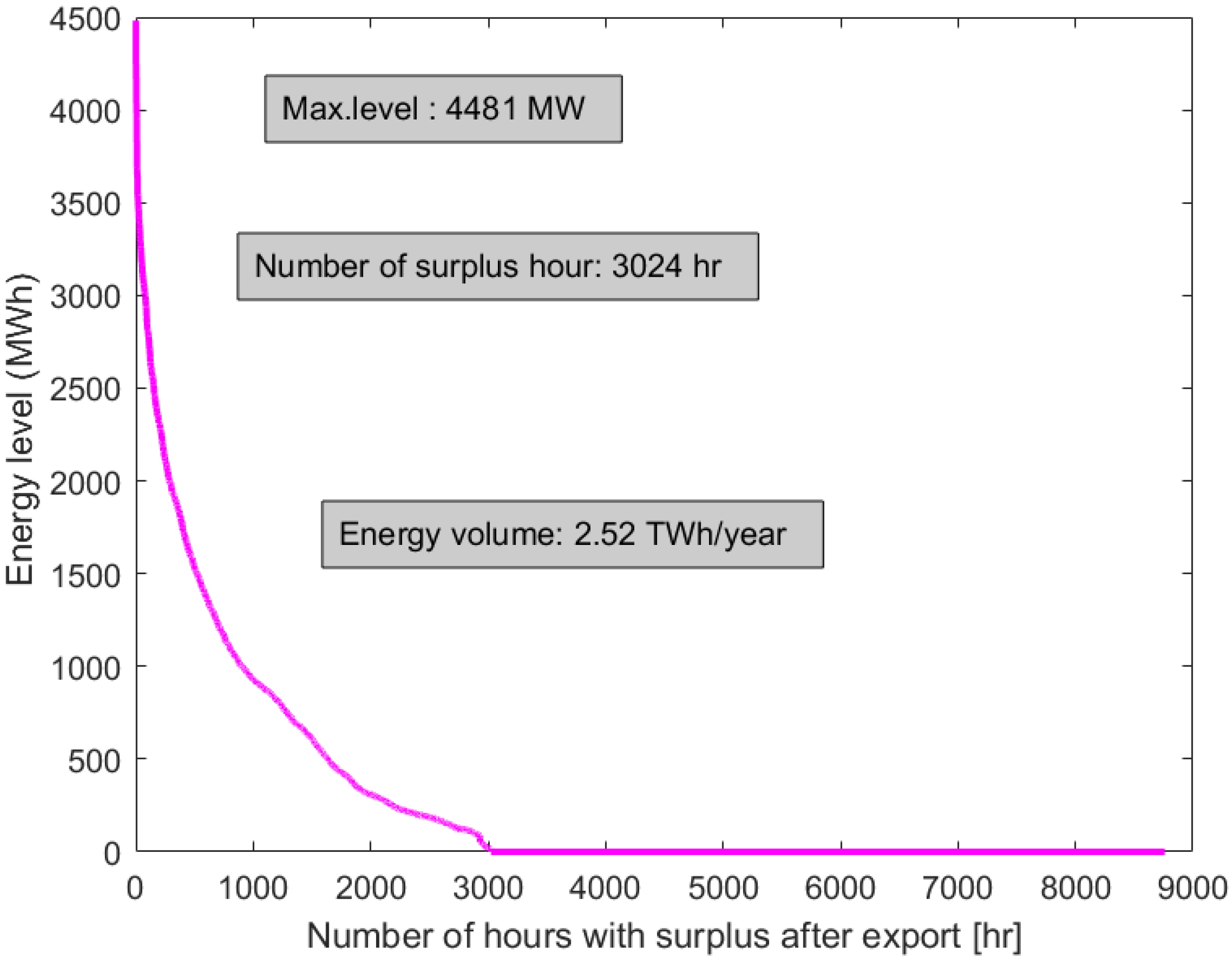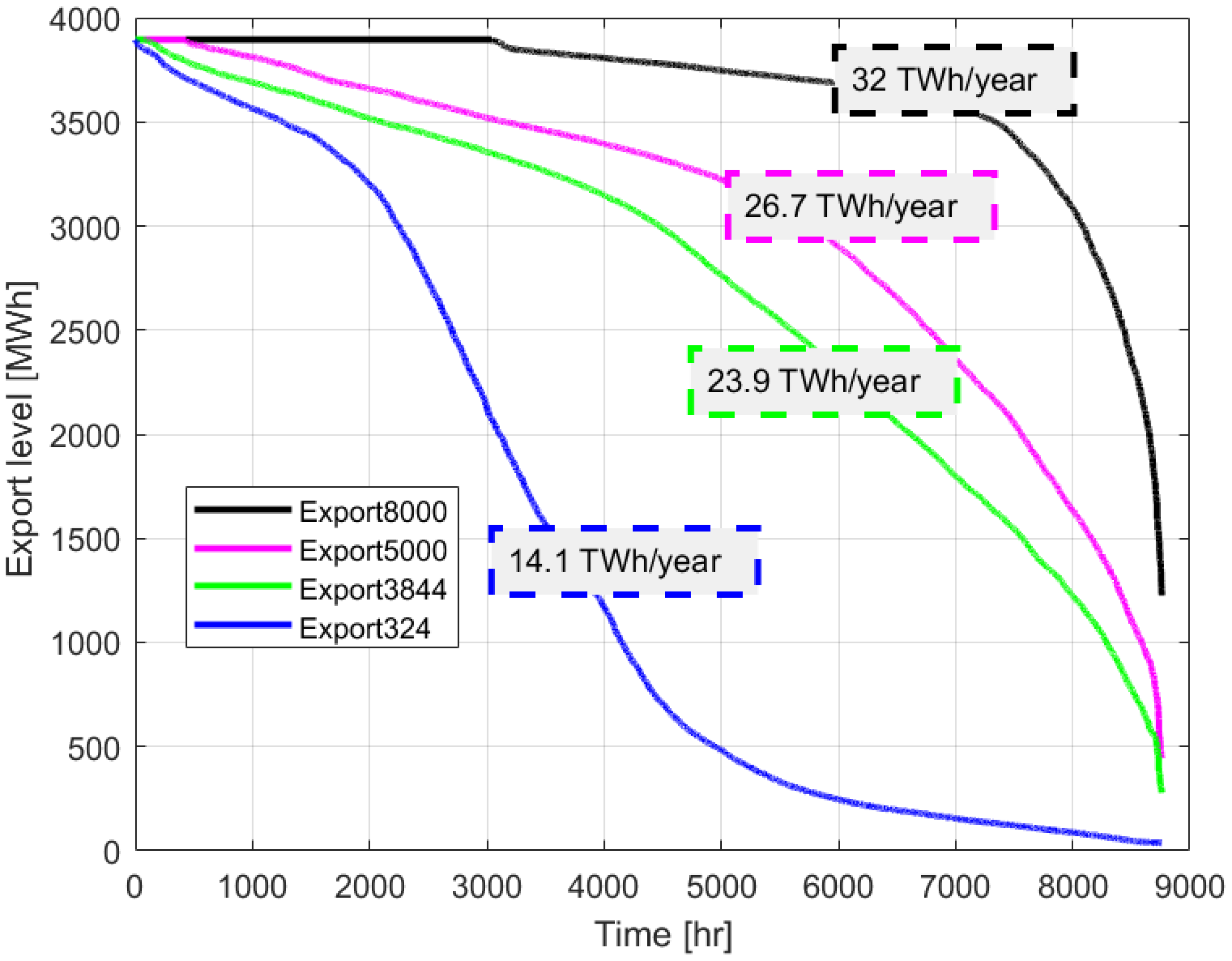1. Introduction
In any electric power system, the total generation should always be exactly the same as the total consumption [
1]. However, it is naturally a challenge for the power system to keep an exact balance between total generation and consumption, including power system losses [
2]. The biggest challenge for many power systems is situations in which there is a sudden and large-scale disconnection from the power plant and a loss of the transmission line [
3,
4]. Another challenge related to keeping continuous balance occurs when variable renewable energy sources, such as wind and solar, are integrated into the national grid [
5,
6]. These studies have identified three challenges for balancing—handling continuous balancing; low wind and solar power production and high power consumption; and situations in which there is high wind and solar power production and low power consumption.
The increase in electricity generation from variable renewable energy sources i.e., from wind and solar, makes the balancing of power systems more difficult. One of the difficulties faced by system operators is when there is more power available from variable renewable sources than can be accommodated by the electric power system grid. During these conditions, the extra power can either be exported to neighboring countries or stored, or generation can be reduced to below the available capacity, which is known as curtailment [
7].
The system balancing problem might lead to curtailment due to a bottleneck in transmission lines, reserve requirements, the minimum generation requirements of conventional power plants, a limited flexibility of the power system, and the integration level of wind and solar power. However, depending on the characteristics and operation rules of the power system, the amount of curtailment and the challenges of system balancing vary between different systems.
In Sweden, by 2025 curtailment is estimated to be 0.3% of the available generation for a 26 GW wind scenario and below 1.7% for a 33 GW wind scenario [
8]. The reason for curtailment is the limited flexibility of thermal power plants and the reduced capacity of transmission lines due to failures.
In the Ethiopian power system, which is largely based on hydropower (more than 93% of total generation in 2020), operators have so far not needed to worry about the curtailment of wind generation due to an insignificant penetration level. However, the rapid increase in wind power capacity in the country will agitate curtailment in the future. Ethiopian Electric Power has a plan to integrate 1450 MW of solar power and 3844 MW of wind power, in addition to the existing plants, by 2030.
There are many studies that have analyzed the need to curtail renewable power generation in future power systems. The authors of [
9] predicted how much wind was to be curtailed in 2020 in the Irish power system. The study identified the impact of the amount of offshore wind on wind curtailment, the allowed limit of system non-synchronous penetration (SNSP), and the inclusion or exclusion of transmission constraints. Another article [
10] studied wind power curtailment in China in 2016 and identified around 49.7 TWh of curtailment per year, which is significant.
Task 25 of the International Energy Agency (IEA) Wind Technology Collaboration program [
11] led to the finding that high penetrations of wind and solar generation in power systems result in increasing curtailment. The paper discussed how much curtailment is occurring, how it is occurring, why it is occurring, and what is being done to reduce curtailment.
Article [
12] assessed how operational flexibility and the curtailment of renewable energy are connected by using a unit commitment and economic dispatch model that included operational characteristics of conventional power plants and system constraints for a power system in Great Britain. The result shows that an increase in curtailment is mostly expected as wind deployment increases. The study found that curtailment reached 17% of the annual available variable renewable electricity generation.
There is a large body of literature related to the balancing of wind power. Article [
13] studied how to balance wind power using demand-side management during high penetrations of wind energy. Other studies [
14,
15,
16,
17,
18] have examined the balancing of wind power using different methods for different countries.
However, there have been no similar studies of the Ethiopian power system. The reason for this is probably that the integrated wind power capacity of Ethiopia is not yet significant. According to the report from the National Electrification Program, in the year 2022 G.C, approximately 40 percent of the population, with a per capita consumption of 143 kWh per year, was connected to the grid despite the large potential of renewable energy resources, particularly wind power [
19] (see
Table 1). The government of Ethiopia (GoE) has set an ambitious plan for the coming year to increase energy generation, particularly from renewable energy, to boost access to electricity and per capita energy consumption [
20]. Thus, an assessment of the expected future balancing challenges and wind power curtailment in the Ethiopian power system is relevant and desirable. This analysis should capture curtailment due to transmission line congestion, limitations in hydro flexibility due to the daily minimum generation for irrigation, and curtailment arising from regulation reserve requirements.
For this purpose, we developed an hourly dispatch model of the Ethiopian power system. The model considers hourly average production values and includes the net transmission line capacity for the neighboring countries. It includes the hourly generation capacities of different types of generation, and uses a cascaded model for hydropower generation. Wind power was modeled based on ERA-5 reanalysis data and information about existing wind farms [
21], and solar power production time series were taken from a meteorological model called the system advisory model [
22].
In this developed model, wind generation curtailment occurs when other types of generation are at their minimum generation limits, there is no more transmission capacity for exporting the excess wind power, and the reserve requirement is increased. Thus, the model was used to assess the system balancing challenge and the amount of wind curtailment under future power system scenarios, considering the expected changes in wind power, load, hydropower generation, and transmission capacity by 2030.
In total, 24 different cases were studied in order to investigate the impact of the amount of wind power and different system configurations on curtailment and system balancing. The results show that the most important measures to reduce curtailment and system balancing would be to increase the transmission capacity of certain connections and to reduce the scheduled irrigation if possible, while regulating reserve requirements has less impact.
Thus, this paper contributes the following novelty to the research community. We develop a model to simulate the Ethiopian power system, which has not been done so far, and the developed model can be seen in (
Section 3 Model Formulation and Case Study Setup). Furthermore, using the model, we analyze the wind power curtailment and system balancing challenges under future scenarios for the Ethiopian power system, considering transmission capacity, regulation reserve requirements, and the minimum generation of hydropower (generation flexibility), and this can also be seen in (
Section 4 Result and Discussion). In addition to this, this paper studies the impacts of operational constraints such as reserve requirement, minimum power generation, and transmission line constraints on system balancing and wind power curtailment challenges.
Thus, the other sections of the paper are summarized as follows:
Section 2 deals with the data and model implementation,
Section 3 explains the mathematical formulation of the model and the case study setup,
Section 4 presents the results and discussions, and finally
Section 5 gives a conclusion and considerations for future work.
4. Result and Discussion
In this section, the results of the case study are presented and discussed. The study has considered different configurations of wind penetration level with some operational constraints to analyze the maximum curtailment of wind power and its effect on system balancing. The configurations of the scenarios are abbreviated as a code for simplicity to explain the results. For example, the configuration code W5000-MP0-R0-TL1 refers to the case with a 5000 MW wind penetration level and 24,000 MWh per day minimum hydropower generation for irrigation, considering 1% regulating reserves, and a 5% reduction in transmission line capacity to neighboring countries. MP shows how the daily minimum hydropower generation affects the flexibility of hydropower and system balancing. Furthermore, R shows how the regulating reserve requirement affects the mentioned objectives, and finally TL shows what the effect of transmission line capacity will be on the system balancing and wind power curtailment.
Table 9 shows the simulation results for wind power curtailment as a percentage of available annual generation capacity for different configurations of operational constraints and wind power scenarios. This means that the simulation results were obtained from the combination of wind penetration level, net transmission line capacity to neighboring countries, daily minimum hydropower generation for irrigation, and regulation reserve constraints. The maximum curtailment is observed during the configuration W8000-MP1-TL1-R1. This maximum curtailment mainly happened due to an increased daily minimum generation of hydropower for irrigation and reduced transmission line capacity.
The net transmission line capacity to neighboring countries significantly affects the wind power curtailment. Decreasing the transmission capacities from full capacity to historical (reduced) values significantly increases curtailment, irrespective of the other configurations. For example, from
Table 9, in the case of W8000-MP1-R0-TL0, curtailment increases from 5.76% to 8.12% because of transmission line congestion.
It can further be concluded from
Table 9 that the regulating reserve will limit the curtailment of wind power to some extent. The effect of the regulating reserve is observed from two directions, i.e., from up- and downregulation depending on the daily minimum generation of hydropower. During high daily minimum hydropower generation, the curtailment is increased due to the downregulation reserve, which was kept from hydropower, and this reserve increases the minimum hydropower generation. The increment in minimum generation in turn increases curtailment. On the other hand, during low daily minimum hydropower generation, the curtailment is decreased due to the upregulation reserve, which was was kept from hydropower. This decreases the generation capacity of the hydropower plants. Then, decreasing the hydropower generation capacity will open the door for wind power to be utilized, which in turn decreases the curtailment.
In general, the low daily minimum hydropower generation does not have much impact on the flexibility of hydropower, so when we increase the regulating reserve, the hydropower decreases from its maximum generating capacity, giving room for more wind power to be generated, which leads to a decrease in curtailment, and the reverse is true for high minimum power. In summary, the regulating reserve has a small impact on curtailment compared to the other two constraints.
For the case of MP, the daily minimum hydropower generation for irrigation leads to curtailment by forcing some parts of the power plants to operate as base load generators. This minimum power generation will limit the flexibility of hydropower for accommodating wind power. From
Table 9, for the case of W8000-MP0-TL1-R1, the curtailment was increased from 1.37% to 9.8% due to an increment in the daily minimum generation of hydropower irrespective of other constraints. Thus, it can be concluded that increasing the daily minimum power generation significantly reduces the flexibility of hydropower, which results in higher curtailment and increases the balancing challenge.
Finally, the wind power in the grid has an impact on curtailment depending on its penetration level. The simulation result from
Table 9 indicates that the maximum curtailment becomes 0.2%, 1.1%, and 9.8% of the wind power annual generation capacity for penetration levels of 3844 MW, 5000 MW, and 8000 MW, respectively, irrespective of the other operational constraints. These results confirm that as the penetration level of wind power increases, its curtailment also increases. The duration curve shown in
Figure 7 also depicts the maximum magnitude of wind power curtailment and how much time per year curtailment occurs.
In this part, the system balancing challenges during high wind and low consumption are to be discussed. The worst balancing challenge can be observed during high curtailment, at which wind is at its peak and consumption is at a low level. This result can be seen in the setup W8000-MP1-TL1-R1 and is depicted in
Figure 8. This figure shows a situation that is not in balance as there is extra generation over several hours, particularly on the first two days. This kind of situation is physically impossible, so the challenge has to be managed either by exporting, storing, or curtailing to bring the system into balance. In this paper, the system comes into balance by exporting and curtailing the extra wind energy. After curtailing the wind power, the result is shown in
Figure 9 indicating that the system is balanced.
From
Figure 10, one can easily observe that there is no curtailed wind power for the case of W8000-MP0-TL1-R1. This is due to the high flexibility of hydropower. This high flexibility of hydropower resulted from the low daily minimum power generation constraint.
As shown in
Figure 11, there are 3024 h/year with curtailment, and the total energy curtailed is 2.52 TWh/year during the configuration W8000-MP1-TL1-R1. This means that 9.8% of all wind power is spilled. Economically, this means that wind energy becomes 9.8% more expensive as not all generation is used. There are other possibilities to use the energy, for example, exporting if a sufficient transmission line is available; charging electric vehicles, which is an upcoming agenda for Ethiopia; and any other alternatives.
One of the methods to reduce the wind power curtailment and system balancing challenge is exporting the extra energy to neighboring countries.
Figure 12 shows the duration curve of export for each wind scenario. From the figure, one can observe that as integration increases export also increases as much as possible relative to the transmission capacity.
5. Conclusions
We have developed and used an hourly dispatch model for the Ethiopian power system to study the amount of wind power curtailment and identify the system balancing challenge for the future Ethiopian power system with 3844 MW, 5000 MW, and 8000 MW wind penetration levels.
The wind curtailment and system balancing challenge is worse when reduced transmission capacity, high daily minimum hydropower generation, and regulation reserve are considered. During this configuration, the wind curtailment becomes 9.8% of the available annual generation capacity for wind power. The regulation reserve requirement has a small impact on curtailment and the system balancing challenge compared to the other constraints.
The most important factors influencing curtailment were the transmission capacity and the minimum generation of hydropower. The daily minimum generation of hydropower limits the flexibility of hydropower, which leads to higher curtailment and worsens the system balancing challenge.
The capacity of wind power in the grid also highly affects the curtailment of wind power. As the magnitude of wind power increases, the curtailment also increases irrespective of other parameters. The curtailment in the system not only affects the operation of the system but also the cost of wind power. This means that as the curtailment increases, the cost of wind power also increases as not all energy from wind is used. In this paper, during the configuration of W8000-MP1-T1-R1, the cost of the wind power increased by 9.8%.
Thus, when integrating wind power into any national grid, the curtailment and balancing challenges have to be studied and the worst scenarios should be identified. In this paper, the worst challenges occurred when there was high daily minimum power and reduced transmission lines to neighboring countries, whereas the reserve requirement had a small impact. Furthermore, the cost of wind power also increases with the same percentage of curtailment.
